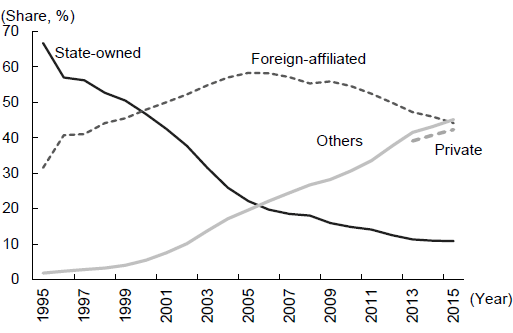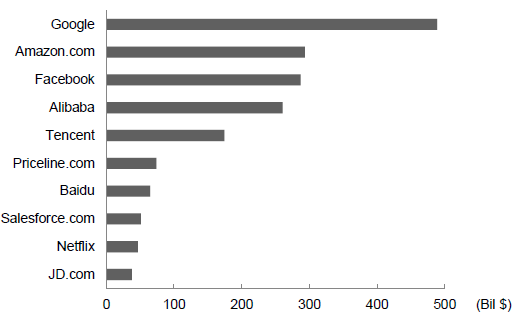In China, private enterprises have made remarkable strides in recent years in areas such as information and communications. In addition to their expanding operating revenues and exports, brand value, popularity as places of employment, and recognition of their innovation capabilities are also growing.
Private enterprises have increased in number in the "Top 500 Chinese Enterprises" (the China Enterprise Confederation and the China Enterprise Directors Association) from 184 in 2011 to 207 in 2015, with their share of operating revenues rising from 17.2% to 21.7%. In addition, while foreign-affiliated companies have long been the central players in the area of exports, the presence of private enterprises is now growing. The share of exports accounted for by foreign-affiliated companies fell from its peak of 58.3% in 2005 to 44.1% by the January to September 2015 period. On the other hand, the share made up by "Others," which consists mainly of private enterprises, rose from a mere 1.8% in 1995 to 45.1% in the same period (Figure 1). It is only a matter of time before private enterprises alone overtake foreign-affiliated companies.
--Private enterprises are becoming the central players--

The brand name recognition of private enterprises is also growing. According to the "Top 100 Most Valuable Chinese Brands" survey conducted by Millward Brown, a British brand research company, and WPP, a leading British advertising company, state-owned enterprises (SOEs) commanded the top five positions in the first survey in 2011, but by 2015, private enterprises have come to make up three of the top five, with Tencent ranked first, Alibaba ranked second, and Baidu ranked fifth (Table 1).
| Ranking | 2011 | 2015 | ||
|---|---|---|---|---|
| 1 | China Mobile | Tencent | ||
| 2 | Industrial and Commercial Bank of China | Alibaba | ||
| 3 | Bank of China | China Mobile | ||
| 4 | China Construction Bank | Industrial and Commercial Bank of China | ||
| 5 | China Life Insurance Company | Baidu | ||
| Source: Compiled by the author based on the "Top 50 Most Valuable Chinese Brands" (2011) and the "Top 100 Most Valuable Chinese Brands" (2015) by Millward Brown and WPP. | ||||
The popularity of private enterprises as places of employment is also rising. In the questionnaire survey on the "Best Employers According to Chinese University Students" conducted by ChinaHR.com in 2014, five private enterprises (Huawei Technologies, Baidu, Tencent, Alibaba, and Dalian Wanda) were ranked in the top 10 (Table 2).
| Ranking | Company name | |||
|---|---|---|---|---|
| 1 | China Mobile | |||
| 2 | Bank of China | |||
| 3 | Huawei Technologies | |||
| 4 | Microsoft | |||
| 5 | Baidu | |||
| 6 | Industrial and Commercial Bank of China | |||
| 7 | P&G | |||
| 8 | Tencent | |||
| 9 | Alibaba | |||
| 10 | Dalian Wanda | |||
| Source: Compiled by the author based on the "Best Employers According to Chinese University Students" (July 2014) survey of ChinaHR.com. | ||||
In addition, the innovation capabilities of private enterprises have been growing steadily. In the 2014 list of the "50 Most Innovative Companies" compiled by the Boston Consulting Group, Lenovo (23rd), Xiaomi (35th), Tencent (47th), and Huawei Technologies (50th), all private Chinese enterprises, were ranked in the top 50.
However, although 94 Chinese companies (excluding companies in Taiwan and Hong Kong) ranked in Fortune's "Global 500" (2015), a ranking based on the size of operating revenue, SOEs still made up the majority, and only eight private enterprises were included in this list (Table 3). Nevertheless, many Chinese private enterprises will ride the tides of marketization in China and technological innovation around the world and break into the Global 500 before long.
| Ranking | Company name | Operating revenue in 2014 ($ billion) | Industry sector | |
|---|---|---|---|---|
| 96 | China Ping An Insurance | 86.0 | Financial | |
| 156 | Pacific Construction | 63.4 | Engineering and Construction | |
| 228 | Huawei Technologies | 46.8 | Technology | |
| 234 | Shandong Weiqiao Pioneering Group | 45.8 | Apparel | |
| 247 | Amer International Group | 43.6 | Industrials | |
| 274 | Jiangsu Shagang Group | 40.3 | Materials | |
| 281 | China Minsheng Banking Corporation | 39.9 | Financial | |
| 477 | Zheijiang Geely Group | 25.0 | Motor Vehicles | |
| Source: Compiled by the author based on Fortune, "Global 500," July 2015 <http://fortune.com/global500/> | ||||
The areas in which the rise of private enterprises is the most prominent are information and communications centering on the Internet, which is undergoing remarkable development. According to the "Top 100 Chinese Internet Companies" (July 2015) compiled by the Internet Society of China and the Information Center of the Ministry of Industry and Information Technology, the top 10 companies were all private enterprises. In addition to the top three Chinese companies of Alibaba, Tencent, and Baidu (sometimes referred to as "BAT"), JD.com, which was fourth on this list, also ranked in the top 10 Internet companies in the world based on market capitalization along with Google, Facebook, and Amazon.com (Table 4, Figure 2).
Like BGI, which conducts genomic analysis, and Da-Jiang Innovations Science and Technology (DJI), a drone manufacturer, Chinese private enterprises that command an overwhelming share of the world market are also emerging in other high-tech areas. In contrast to the sluggish performance of SOEs in areas such as resources and heavy industry, which are facing an economic downturn, the surge of private enterprises in high-tech areas with growth potential is a very positive sign for the economic development of China.
| Company name | Baidu (Baidu) | Alibaba | Tencent | |
|---|---|---|---|---|
| Established | January 2000 | September 1999 | November 1998 | |
| Founder | Robin Li (1968 - ) | Jack Ma (1964 - ) | Ma Huateng (1971 - ) | |
| Head office | Beijing | Hangzhou | Guangdong | |
| Number of employees (2014) | 46,391 | 34,081 | 27,690 | |
| Operating revenue (2014) | 49.05 billion yuan | 70.81 billion yuan | 78.93 billion yuan | |
| Net income (2014) | 13.19 billion yuan | 26.97 billion yuan | 23.81 billion yuan | |
| Listing | NASDAQ (August 2005) | New York Stock Exchange (September 2014) | Hong Kong Exchanges and Clearing Main Board (June 2004) | |
| Main business | Search engine, advertising, cloud computing, etc. | E-commerce platforms such as Tmall.com and Taobao | QQ (instant messenger), WeChat (SNS), and online games, etc. | |
| Source: Compiled by the author based on information from the company websites and the "Top 500 Chinese Companies for 2015" list by Fortune China, etc. | ||||

The original text in Japanese was posted on November 24, 2015.


